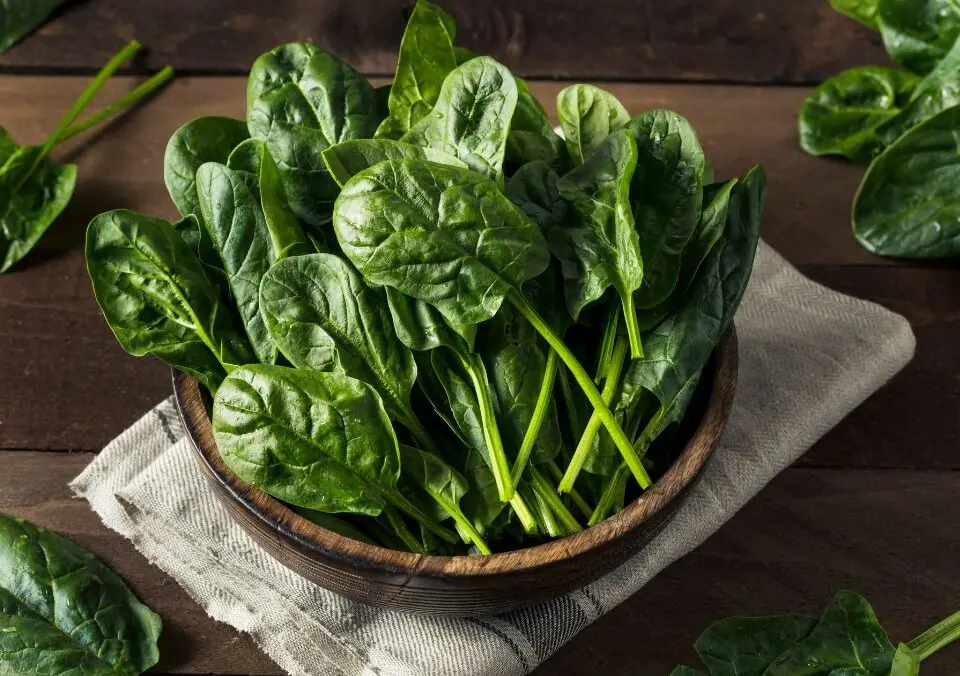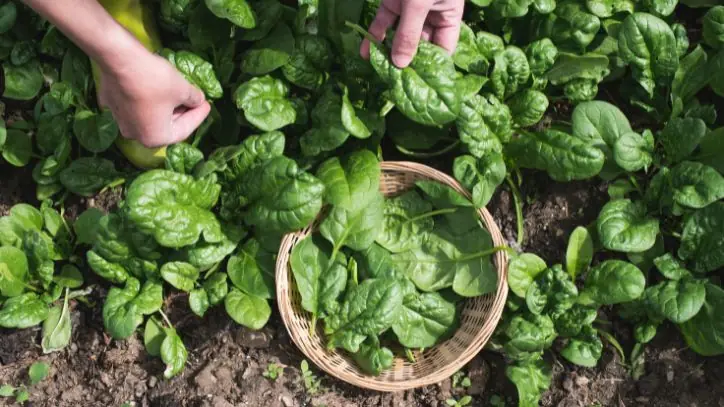Blog
What Nutrition Does Spinach Have: Unpacking Spinach’s Health Benefits and Arizona’s Agricultural Legacy

I’ve concluded that spinach is my favorite vibrant and healthy leafy green. I add it to my scrambled eggs to my breakfast menu every morning. As a result, it’s become a staple in my diet.
Recently, a friend asked me about the nutritional value of spinach and so I decided to turn the topic into an article since it’s one of our top leafy greens grown in Yuma, Pinal and Maricopa counties during the winter months in Arizona.
Spinach, the vibrant green leafy vegetable often celebrated in cartoons and kitchens alike, has earned its reputation as a nutritional superstar. From Popeye’s bulging biceps to modern superfood salads, spinach packs a punch of vitamins, minerals, and antioxidants that support everything from bone health to immune function. But beyond its role on the dinner plate, spinach is a cornerstone of American agriculture, particularly in Arizona.
According to the United States Department of Agriculture (USDA), Arizona ranks second in the nation for spinach production, contributing nearly 20% of the U.S. total in recent years.
A Brief History of Spinach: From Persia to the Desert Southwest
Spinach (Spinacia oleracea) traces its origins to ancient Persia around the 4th century, where it was known as “the green in oil” for its preparation in olive oil. Arab traders introduced it to Europe in the 11th century, and by the 16th century, it had become a staple in English gardens. In the United States, spinach production boomed in the early 20th century, with California leading the charge. However, Arizona’s arid climate and innovative irrigation systems have made it a key player, especially for winter harvests when other regions face frost.
Today, spinach is grown year-round in controlled environments, but Arizona’s Yuma County, often called America’s Winter Vegetable Capital, specializes in baby spinach and bunching varieties. The state’s production is bolstered by the Colorado River’s waters, diverted through vast canal systems. Arizona’s spinach growers grow this important leafy green with precision agriculture, drip irrigation, and cover crops to maintain yields. This resilience not only feeds the nation but also underscores spinach’s adaptability, mirroring its nutrient-dense versatility in diets worldwide.

The Nutritional Breakdown: What Makes Spinach So Special?
At its core, spinach is a low-calorie powerhouse, offering an abundance of nutrients with minimal caloric impact. According to USDA data, 100 grams of raw spinach contains just 23 calories, making it an ideal addition to weight-conscious meals. This serving size provides 2.86 grams of protein, about 5.7% of the daily value (DV) for a 2,000-calorie diet—along with 0.39 grams of total fat, primarily healthy unsaturated fats. Carbohydrates clock in at 3.63 grams, including 2.2 grams of dietary fiber, which aids digestion and promotes satiety.
But spinach’s true magic lies in its micronutrients. It’s an exceptional source of vitamins A, C, and K, which are crucial for vision, immunity, and blood clotting, respectively. Per 100 grams:
- Vitamin A: 469 micrograms (52% DV), supporting eye health and immune function.
- Vitamin C: 28.1 milligrams (31% DV), an antioxidant that boosts collagen production and fights free radicals.
- Vitamin K: 482.9 micrograms (402% DV), essential for bone metabolism and preventing excessive bleeding.
Minerals abound as well. Spinach delivers 558 milligrams of potassium (12% DV), helping regulate blood pressure, alongside 79 milligrams of magnesium (19% DV) for muscle and nerve function. Calcium stands at 99 milligrams (8% DV), though its absorption is enhanced by spinach’s vitamin K. Iron, often spinach’s claim to fame, provides 2.71 milligrams (15% DV), vital for oxygen transport—pair it with vitamin C-rich foods to maximize uptake. Folate (vitamin B9) at 194 micrograms (49% DV) supports DNA synthesis and is particularly important during pregnancy.
Other notables include manganese (0.9 milligrams, 39% DV) for bone health and metabolism, and smaller amounts of zinc, copper, and selenium for antioxidant defense. Spinach also contains lutein and zeaxanthin, carotenoids that protect against age-related macular degeneration. These nutrients are bioavailable in both raw and cooked forms, though cooking reduces oxalates, which can inhibit mineral absorption.
| Nutrient (per 100g raw spinach) | Amount | % Daily Value* |
|---|---|---|
| Calories | 23 | 1% |
| Protein | 2.86 g | 6% |
| Total Fat | 0.39 g | 1% |
| Carbohydrates | 3.63 g | 1% |
| Dietary Fiber | 2.2 g | 8% |
| Vitamin A | 469 mcg | 52% |
| Vitamin C | 28.1 mg | 31% |
| Vitamin K | 483 mcg | 402% |
| Calcium | 99 mg | 8% |
| Iron | 2.71 mg | 15% |
| Potassium | 558 mg | 12% |
| Magnesium | 79 mg | 19% |
| Folate | 194 mcg | 49% |
*Based on a 2,000-calorie diet.
This profile positions spinach as a “nutrient density” champion, scoring high on the Aggregate Nutrient Density Index (ANDI), which measures vitamins and minerals per calorie. Raw spinach retains more heat-sensitive vitamin C, while steaming preserves folate better than boiling.
Health Benefits Backed by Science
The nutrients in spinach translate into tangible health perks. Its high vitamin K content supports cardiovascular health by preventing arterial calcification; studies link adequate intake to a 20 to 30% reduced risk of heart disease. Vitamin C and antioxidants like quercetin combat oxidative stress, potentially lowering inflammation and chronic disease risk.
For eye health, the lutein and beta-carotene in spinach filter harmful blue light, reducing cataract and macular degeneration odds by up to 40%, per eye health research. Iron and folate aid anemia prevention, especially in vegetarians, while potassium helps manage hypertension—affecting nearly half of U.S. adults.
Spinach’s fiber promotes gut health, feeding beneficial bacteria and stabilizing blood sugar. Emerging research suggests its nitrates improve exercise performance by enhancing blood flow, akin to beetroot’s effects. In cancer prevention, sulforaphane and other compounds may inhibit tumor growth, though more human trials are needed.
Incorporating spinach is simple: blend into smoothies for hidden nutrition, wilt into pasta sauces, or sauté as a side. Aim for 1-2 cups daily to reap benefits without oxalate overload, which can contribute to kidney stones in susceptible individuals.
Arizona’s Spinach Boom: USDA Insights into Desert Farming
Arizona’s vegetable sector is an economic engine, with spinach playing a starring role. The USDA’s National Agricultural Statistics Service (NASS) reports that in 2023, the state’s utilized vegetable production value reached $19.5 billion, up slightly from the prior year, driven by leafy greens like spinach. Tomatoes and romaine lettuce dominate, but spinach’s value hit $153.3 million that year, reflecting robust demand for fresh, local produce.
Yuma County accounts for most of Arizona’s baby spinach, with minimal bunching varieties. Nationally, Arizona trails only California (69.4% share), but its winter production fills critical gaps, supplying 30 to 40% of U.S. fresh spinach from November to March. In 2024, harvested acres were withheld to protect proprietary data, but trends suggest stability, with overall vegetable acres at around 200,000.
Broader Arizona veggie statistics paint a picture of diversity. Lettuce dominates with 64,200 harvested acres in 2024, according to the United States Department of Agriculture (head: 26,800; leaf: 11,400; romaine: 26,000), yielding $934.1 million—up 7% from 2023. Broccoli (12,500 acres, 1.438 million cwt) and cauliflower (6,300 acres, 1.166 million cwt) add nutritional variety, while melons like watermelons (3,600 acres, 1.692 million cwt) round out the portfolio. Cash receipts from vegetables and melons totaled $1.56 billion in 2022, comprising over 30% of the state’s $5.24 billion ag receipts.
These figures underscore Arizona’s irrigation prowess; 897,330 irrigated acres support high-value crops. Exports hit $184.7 million for fresh veggies in 2022, bolstering trade.
Culinary and Sustainable Tips for Enjoying Arizona Spinach
Sourcing Arizona spinach means fresher, nutrient-replete greens, often picked within days of market arrival. Try a quinoa-spinach salad with citrus for vitamin synergy or spinach-artichoke dip for a crowd-pleaser.
Spinach’s nutrition—from its vitamin-packed leaves to mineral-rich profile—makes it indispensable for health. Arizona’s USDA-tracked bounty ensures abundance, blending desert ingenuity with nutritional legacy. Next time you crunch into a spinach salad, remember it’s not just fuel for the body, but a harvest of human endeavor.
Julie Murphree, Arizona Farm Bureau Communications Director


















